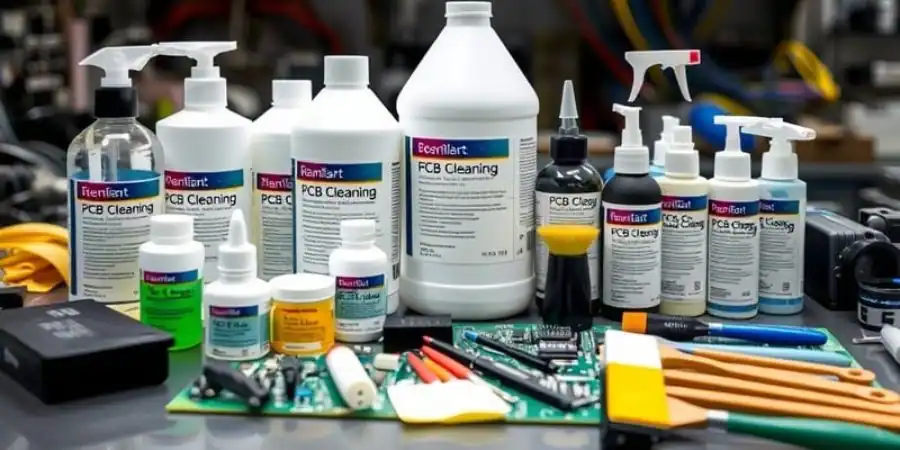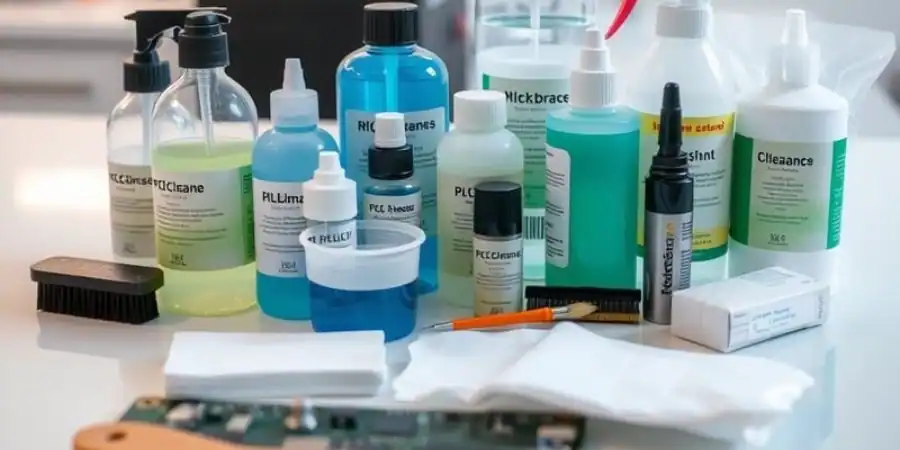Buy the Safest PCB Cleaning Chemicals
Introduction:
In PCB manufacturing, chemicals and consumables play a key role in the performance, durability and reliability of the end product.
India is steadily increasing its export of various PCB chemicals like solder pastes, adhesives, solder fluxes and cleaning materials. This is a positive transformation, considering the nation’s history of importing chemicals since the 1999s. Local production of PCB chemicals is on the rise due to an increase in demand, as the electronics industry has made great progress. The competitiveness of India’s PCB manufacturing sector will depend to a certain extent on the quality, price and supply of the chemicals it uses.

The types of chemicals and their importance:
Cleaning and de-greasing of electronic assemblies, PCBs and stencils are crucial for their longevity and consistent performance. PCB chemicals are used to clean thinning plastics, resins, glues, Inka, paints and waxes. There is a wide variety of PCB chemicals available in the market, like wet cleaners, solder pastes, solvents, conformal coating, anti-static protection products, stencils, the safe-wash range, and low VOC (volatile organic compounds) lubricants and resins, to name a few.
The cleaning process using PCB chemicals can be categorized into two types – wet process cleaning and dry cleaning.
Wet process cleaning technologies are the most used methods in microelectronics cleaning, accounting for about 89 per cent of cleaning process. They are used for PCBs, memory disks, electronic packaging and finishing, and in the photovoltaics industry.
Dry cleaning technologies are implemented in the remaining 11 per cent of applications. The process includes thermosetting single components and solvent-free polymer adhesive, developed especially for the surface mounting of components on PCBs and for use on bare substrates.

Different types of PCB chemicals and their application:
There are chemicals used in every step of PCB production. The various types include the following:
- Solder resist chemicals: Though there are many types of such chemicals available, they are rarely specified and can cause incompatibilities with coatings and solder flux residues.
- Solder fluxes: These are very important for long term reliability, and provide good soldering and residues that are chemically stable over long periods.
- Conformal coatings: This is the last chemical on the board and seals in all the others.
Why you should PCB cleaning chemicals:
Components of solder paste (resins, rosins and flux) are integral to the PCB manufacturing process, but if residues from these elements are left uncleaned for long period of time, they can create problem. So it is very important to use PCB cleaning chemicals to remove the contaminations like flux residues from assembles which is a crucial part of any reliability engineering process and serves as a protective risk mitigation against field failure.
Latest innovations and miniaturization in PCB cleaning chemicals:
Based on customer demand, most PCB chemicals nowadays are water-based or aqueous. This makes them safer to use, with no foam or flash point. It also ensures a safer environment. Aqueous chemicals can be used safely in all spray-in-air equipment like inline or batch systems.
Miniaturization is an important trend in electronics. With the size of the components coming down to 0.1 mm, cleaning the circuits requires finesse. Cleaning chemicals are being altered and designed accordingly, so that low standoff components can also be cleaned without any problem.
Chris Palin, EMEIA manager, HumiSeal, says that one of the latest changes in the PCB chemical industry is the wide availability of lead-free options. The other major change is the operating temperature. He states that the chemicals used today in electronics production remain on the board and survive the higher standard operating temperatures, which are gradually increasing. “Survivability up to 150 degrees Celsius is becoming the norm. Previously, the standard was 125 degrees Celsius,” he says. “Lead-free PCBs have introduced a potential problem of tin whiskers. Conformal coatings can mitigate this issue if the correct type is used,” he adds.
However, the level of R&D and innovation has been limited across the country, causing concern within the PCB chemicals industry. Though the electronics manufacturing industry is growing, but most of the innovations are still happening only in the local units of foreign companies – even for the quality parameters necessary for the industry. Local manufacturers of chemicals thus need to find a way to focus on more innovation.
How to Choose PCB Cleaning Chemicals:
Every type of PCB chemical has its own purpose, benefit and composition. Choosing the appropriate chemical is crucial to ensure the least running expenses. For instance, choosing a water-based chemical is recommended for easy storage and safer handling. Partnering with a reliable supplier is also essential to ensure good quality chemicals, timely delivery and proper accountability.
Solvents are easy to handle during the PCB cleaning process because they evaporate fast. Moving chemicals from one place to another should be done with caution. Producers are responsible for delivering safe, effective and easy-to-use chemicals and consumables to the market. But buyers, too, should ensure they choose chemicals that are not hazardous.
It is suggested that companies should develop their own internal standards for selection, as the needs of various applications are different. This should be done by using the relevant aspects of existing international standards, as no one standard suits all. For instance, using the surface insulation resistance testing (SIRT) for flux residues and coatings, and for testing the surface energy of solder resists (adhesion of coatings); Bono testing for potentially corrosive chemical combinations etc.
You May Like To Read:
